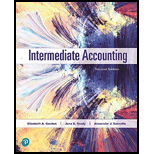
Intermediate Accounting (2nd Edition)
2nd Edition
ISBN: 9780134730370
Author: Elizabeth A. Gordon, Jana S. Raedy, Alexander J. Sannella
Publisher: PEARSON
expand_more
expand_more
format_list_bulleted
Question
Chapter 21, Problem 1BCC
1.
To determine
Whether the retrospective method is the correct approach to use for changes in accounting principles.
2.
To determine
Whether the indirect effects should be applied retrospectively or prospectively.
Expert Solution & Answer
Want to see the full answer?
Check out a sample textbook solution
Students have asked these similar questions
Quick answer of this accounting questions
Listed below are terms associated with the steps of the accounting processing cycle. Pair each item from List A with the item from List
B that is most appropriately associated with it.
List A
1. Source documents
2. Transaction analysis
3. Journal
4. Posting
5. Unadjusted trial balance
6. Adjusting entries
7. Adjusted trial balance
8. Financial statements
9. Closing entries
10. Post-closing trial balance
List B
The Marchetti Soup Company entered into the following transactions during the month of June: (1) purchased inventory on account for
$165,000 (assume Marchetti uses a perpetual inventory system); (2) paid $40,000 in salaries to employees for work performed during
the month; (3) sold inventory on account to customers for $200,000 that had a cost of $120,000; (4) collected $180,000 in cash from
credit customers; and (5) paid on account to suppliers of inventory $145,000.
Analyze each transaction and show the effect of each on the accounting equation for a corporation.
Note: Amounts to be deducted should be indicated by a minus sign. Enter the net change on the accounting equation.
Assets
GETNE
(3)
(4)
(5)
(1)
(2)
Liabilities
Paid-in capital
+
Retained Earnings
+
+
+
+
+
+
+
+
+
Chapter 21 Solutions
Intermediate Accounting (2nd Edition)
Ch. 21 - Are accounting changes permitted in financial...Ch. 21 - How do firms report accounting changes under the...Ch. 21 - Prob. 21.3QCh. 21 - How do firms account for changes in accounting...Ch. 21 - Prob. 21.5QCh. 21 - Prob. 21.6QCh. 21 - Prob. 21.7QCh. 21 - Prob. 21.8QCh. 21 - Do accounting errors that self-correct within two...Ch. 21 - Does a firm need to correct an error that...
Ch. 21 - Prob. 21.1MCCh. 21 - Prob. 21.2MCCh. 21 - Prob. 21.3MCCh. 21 - Prob. 21.4MCCh. 21 - Prob. 21.5MCCh. 21 - Prob. 21.1BECh. 21 - Prob. 21.2BECh. 21 - Prob. 21.3BECh. 21 - Prob. 21.4BECh. 21 - Change in Accounting Principle, Long-Term...Ch. 21 - Prob. 21.6BECh. 21 - Prob. 21.7BECh. 21 - Prob. 21.8BECh. 21 - Prob. 21.9BECh. 21 - Prob. 21.10BECh. 21 - Prob. 21.11BECh. 21 - Prob. 21.12BECh. 21 - Prob. 21.13BECh. 21 - Prob. 21.14BECh. 21 - Change in Accounting Principle, Inventory. Massi...Ch. 21 - Change in Accounting Principle, Long-Term...Ch. 21 - Prob. 21.3ECh. 21 - Change in Accounting Principle, Inventory. Winthur...Ch. 21 - Prob. 21.5ECh. 21 - Prob. 21.6ECh. 21 - Error Analysis and Correction. Feinstein and...Ch. 21 - Prob. 21.8ECh. 21 - Prob. 21.9ECh. 21 - Prob. 21.10ECh. 21 - Change in Accounting Principle, Inventory. Second...Ch. 21 - Prob. 21.2PCh. 21 - Prob. 21.3PCh. 21 - Prob. 21.4PCh. 21 - Prob. 21.5PCh. 21 - Change in Estimate, Inventory, Bad Debt Expense....Ch. 21 - Prob. 21.7PCh. 21 - Cases Judgment Case Judgment Case: Materiality and...Ch. 21 - Prob. 1FSCCh. 21 - Surfing the Standards: Change in Accounting...Ch. 21 - Prob. 1BCC
Knowledge Booster
Similar questions
arrow_back_ios
SEE MORE QUESTIONS
arrow_forward_ios
Recommended textbooks for you
 Auditing: A Risk Based-Approach to Conducting a Q...AccountingISBN:9781305080577Author:Karla M Johnstone, Audrey A. Gramling, Larry E. RittenbergPublisher:South-Western College Pub
Auditing: A Risk Based-Approach to Conducting a Q...AccountingISBN:9781305080577Author:Karla M Johnstone, Audrey A. Gramling, Larry E. RittenbergPublisher:South-Western College Pub Auditing: A Risk Based-Approach (MindTap Course L...AccountingISBN:9781337619455Author:Karla M Johnstone, Audrey A. Gramling, Larry E. RittenbergPublisher:Cengage Learning
Auditing: A Risk Based-Approach (MindTap Course L...AccountingISBN:9781337619455Author:Karla M Johnstone, Audrey A. Gramling, Larry E. RittenbergPublisher:Cengage Learning Intermediate Accounting: Reporting And AnalysisAccountingISBN:9781337788281Author:James M. Wahlen, Jefferson P. Jones, Donald PagachPublisher:Cengage Learning
Intermediate Accounting: Reporting And AnalysisAccountingISBN:9781337788281Author:James M. Wahlen, Jefferson P. Jones, Donald PagachPublisher:Cengage Learning

Auditing: A Risk Based-Approach to Conducting a Q...
Accounting
ISBN:9781305080577
Author:Karla M Johnstone, Audrey A. Gramling, Larry E. Rittenberg
Publisher:South-Western College Pub

Auditing: A Risk Based-Approach (MindTap Course L...
Accounting
ISBN:9781337619455
Author:Karla M Johnstone, Audrey A. Gramling, Larry E. Rittenberg
Publisher:Cengage Learning

Intermediate Accounting: Reporting And Analysis
Accounting
ISBN:9781337788281
Author:James M. Wahlen, Jefferson P. Jones, Donald Pagach
Publisher:Cengage Learning
